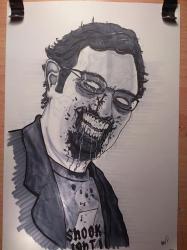Yep, we’re back with Star Trek. And this time, there’s a good reason for it.
Y’see, Star Trek, in its many forms and guises, has been one of the most influential science fiction franchises in history, potentially only second to Doctor Who. It pulled space opera from the campy Saturday Matinee territory it had languished in since the invention of the moving picture and brought it to a weekly television audience. It proved you could do a serious drama with action and (for 1966) decent visual effects and produce science fiction for an adult audience, not just for kids. Put simply, it’s highly likely that without the previous success of Star Trek, George Lucas would have been laughed off the 20th Century Fox lot in 1975 when he asked for $11 million to make a film about telekinetic space wizards and interstellar Nazis. And now, in 2016, we’re in the fiftieth anniversary year of the first broadcast of Star Trek.
So then, time for a look back. As is usual in these IIRTG segments, I pick a particular movie or TV episode in a franchise and proceed to deconstruct it. This time, what is considered one of the best of the classic series: Balance of Terror.
Fifty years ago, most of what is now considered Star Trek cliché hadn’t even been formulated, let alone had time to evolve into the kind of awful technobabble that plagued later series in the franchise. So when author Paul Schneider started on his concept to create a parallel to the Roman Empire in space with the Romulans, there was no concept of big blue wobbly things in space that were called anomalies; there was no firm definition of what impulse and warp engines really were; nobody had decided for sure what phasers were and what they could do; the Federation as a concept did not yet exist; and nobody had made a decision on what kinds of stories were ‘Star Trek-y’ enough.
So Schneider did a World War II story, transplanted three centuries into the future. The setup is simple: an undetectable enemy is attacking Earth (not Federation) outposts along the border with the Romulan Star Empire. A century earlier, Earth and Romulus had fought a deep-space war that ended with a buffer Neutral Zone being created along their mutual border. Neither side even knew what the other looked like. And now, that hundred-year truce was about to be broken. The Romulans have invented a claking device, a form of stealth that makes them invisible to all sensors. Even visual ones. Captain Kirk and the Enterprise have to prevent the intruding ship from returning to base with details of how easily it could overcome their defences, lest it persuade the Romulan leadership that they could win another war. All the Enterprise crew know is that they can outrun and possibly outgun the Romulan ship, if only they could find it.
It’s this simple premise, similar to a dozen submarine movies of the 40s and 50s, that allows Schneider to expose one of the major taboos of Gene Rodenberry’s utopia: racism. It’s something that was alive and kicking when the episode was written: two years before the episode filmed, Lyndon Johnson signed the Civil Rights Act of 1964 into law in the USA, ending racial segregation of schools, open spaces and public transport, amongst others, and the fallout from some sectors of American society was still being felt. Star Trek only really looked at prejudice as openly as this once more, with 1991’s superb Star Trek VI. Even Deep Space Nine’s Founders, arguably the most xenophobic species ever to feature in the franchise, were not as openly hostile as one Lieutenant Stiles.
Stiles was serving as the Enterprise’s navigation officer, in the days before the producers tried to capitalise on the popularity of floppy-haired pop stars and created the Monkee-like Pavel Chekhov. Stiles’s family had suffered several losses in the Earth-Romulan War, and when the Enterprise intercepts a transmission from the invading ship, he immediately turns on Spock with frankly staggering amounts of prejudice. Y’see, it turns out that Romulans and Vulcans share a common ancestry and look almost exactly the same. In scenes that would be played out in reality during the Vietnam War and its aftermath, Stiles lays into Spock with the kind of ‘they all look the same’ stupidity you hoped we left behind in the first half of the 20th Century.
The Romulan commander, clearly a family man of great moral character, had disliked the sneaking about aspect of his mission and feared the destruction a new war would wreak on his people. However, he does his duty. The Earth outposts destroyed, he heads for home to bring news of how easy it was to overcome their defences.
Naturally, the Enterprise pursues, using the Romulan ship’s movement through the interstellar medium as a rudimentary form of imprecise tracking. Scotty is confident that the Enterprise is faster, meaning they can catch the enemy ship if they can only get a precise enough sensor fix to shoot at it. As time went on, the Romulan commander and Kirk began to respect each others’ skill, playing a game of cat and mouse over the span of billions of miles. Using things like the tail of a comet to try and track the Romulan ship, while the Romulans also use it to determine if the Enterprise is a sensor echo or not, the two ships fire at each other and, while targeting is difficult, score hits and do some damage. The Romulans resort to dumping a nuclear warhead in the Enterprise’s path along with spare parts and debris, heavily damaging the ship. Despite the commander’s reticence and a dwindling fuel supply, his crew convince him to backtrack and finish their enemy who, unbeknown to them, still has fully operational phasers.
It takes a phaser coolant leak and the ship’s erstwhile science officer dragging Stiles out of a compartment flooded with the choking gas, for the man to realise the error of his ways. This scene, in the last act of the episode, gives us a double dose of emotional impact. Despite the gas, Spock manages to fire the phasers and cripple the Romulan ship. With his fuel reserves depleted and vessel crippled, the Romulan commander is only left with one course of action. His sense of duty will not let him violate orders and surrender, lest Starfleet get their hands on Romulan technology. Saluting Kirk and mentioning that, in another world, the two would have been friends, he destroys his ship.
The second kick to the feels links back to a scene at the start of the episode where Kirk presides over the marriage of two crew members. The groom, Tomlinson, was also on duty in the gas-flooded phaser room, but Spock was too late to pull him out alive. The episode ends with Kirk finding his distraught bride-to-be alone in the ship’s chapel, reminding a viewing public embroiled in one of the bloodiest wars of the Cold War era that nobody truly wins in war: there are always casualties on both sides.
So the question remains: is it really that good? After almost 50 years, does the episode still stand up to scrutiny? The simple answer is, yes. There’s bad points, naturally. By modern standards the effects work is appalling (although this is somewhat rectified in the HD remastered editions that included new CGI replacing the models) and the eyeball-melting primary colours of the costumes and sets just scream that colour TV was new and somebody at CBS wanted to make the most of it with as many contrasting colours as possible. But, again, these are minor niggles in the face of a storyline and several performances (yes, even Shatner) that are nothing short of excellent. Best episode of Star Trek ever? Not quite. Best episode of The Original Series? No doubt.




Nerd Comments